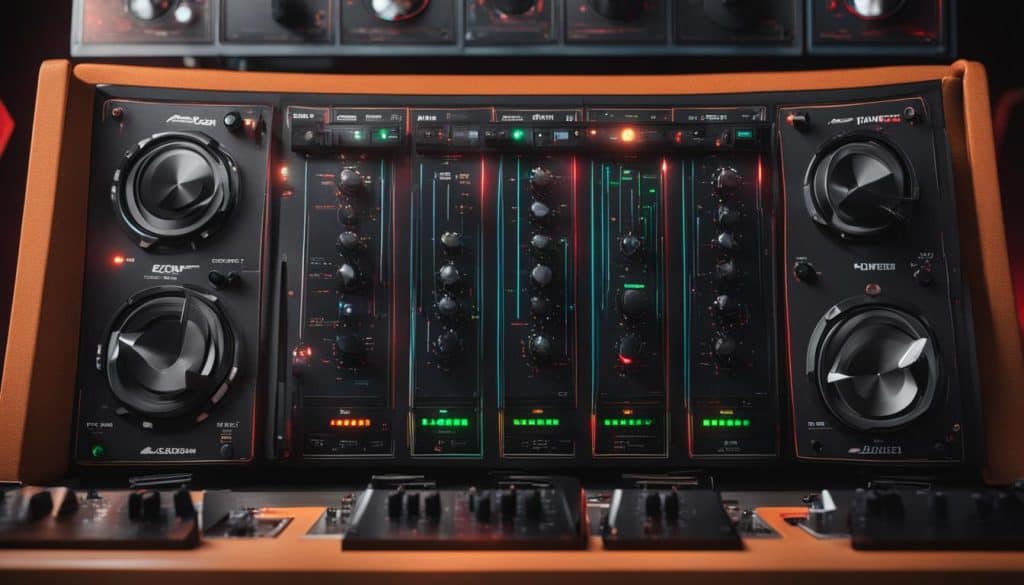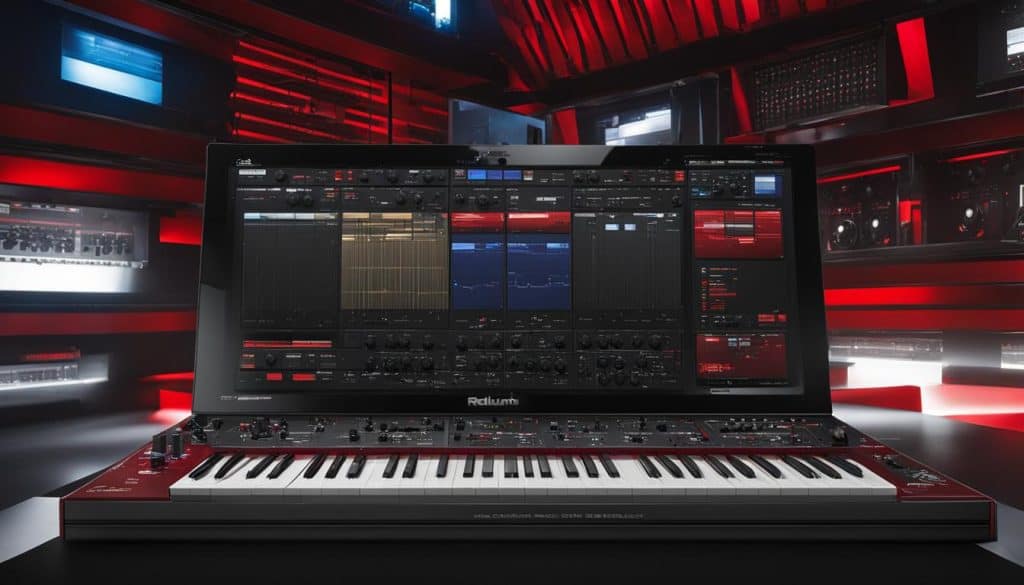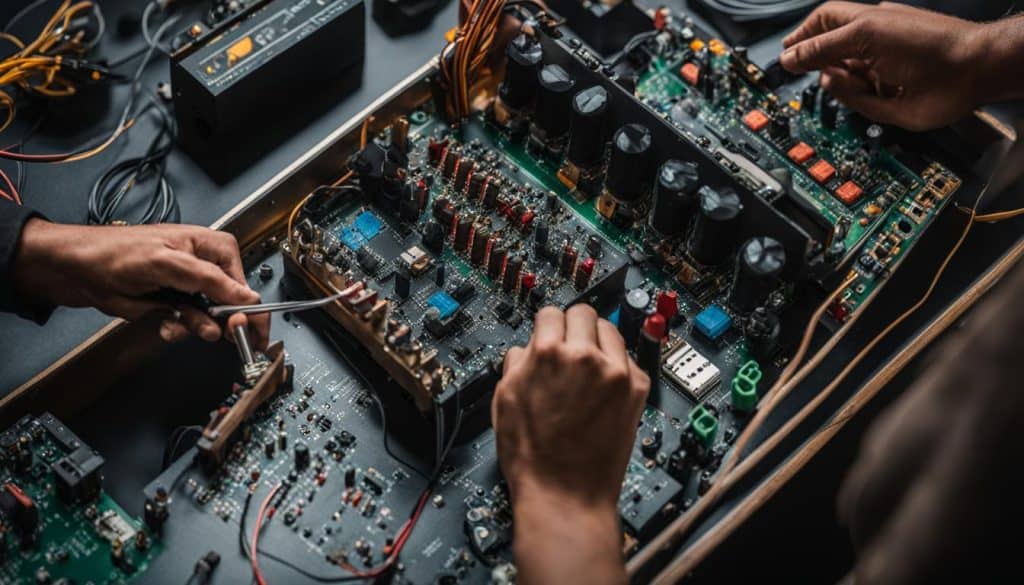I know how important it is to have a unique sound that sets you apart from the rest. Drum sound modules play a central role in shaping the drumming experience, and understanding their technology can help elevate your performance to the next level.
Digital sound synthesis, sample playback, and processing are the building blocks of drum sound modules. These powerful tools allow drummers to create a wide range of sounds and styles, making it possible to customize each performance and express their musical individuality.
Whether you’re a beginner or a seasoned pro, understanding the different types of sound modules and how they connect to your drum kit and external devices is crucial. Troubleshooting and maintenance can also help keep your sound module in optimal condition.
In this article, we’ll explore the heart of the beat – drum sound modules. With practical advice, insights, and notable brands and models, we’ll help you better understand the technology behind these fascinating devices and their significance in shaping the drumming experience.
< class="wp-block-separator has-alpha-channel-opacity"/>Exploring Different Types of Sound Modules
When it comes to sound modules, there are several different types to choose from. In this section, I’ll explain the differences between all-in-one units, software-based options, and hybrid modules, so you can make an informed decision when selecting the right sound module for your drum kit.
All-in-one Units
All-in-one units provide a complete solution in a single package. These units include built-in sounds, sample playback capabilities, and processing features – everything you need to get started.
All-in-one units are ideal for drummers who want a straightforward experience with minimal setup or customization required. They are also a great option for those who want to keep things compact and don’t want to clutter their setup with additional gear.
Software-Based Options
Software-based sound modules utilize computer software to generate sounds. These modules can be run on a variety of devices, including laptops, tablets, and smartphones.
Software-based options offer drummers a high level of customization, allowing them to tweak and adjust sounds to fit their specific preferences. They are also a great option for drummers who are comfortable with technology and want to take advantage of the latest advances in digital sound synthesis.
Hybrid Options
Hybrid sound modules combine the best of both worlds, offering a blend of hardware and software capabilities. These modules allow drummers to take advantage of both built-in sounds and software-based customization.
Hybrid options are suitable for drummers who want a high degree of customization but still want the convenience of an all-in-one unit. They are also a great option for drummers who want to experiment with new sounds and styles.
So there you have it, the different types of sound modules available. Whether you’re looking for a straightforward solution, a high level of customization, or something in between, there’s a sound module out there that will meet your needs.
< class="wp-block-separator has-alpha-channel-opacity"/>Sound Generation and Customization
In my previous section, we explored the different types of sound modules available in the market. Now, we will talk about sound generation and customization and how it can help drummers create unique sounds to express their individuality.
The beauty of sound modules is that they allow drummers to create their own drum kit configurations. It means that drummers can choose which sounds they want to produce, as well as the placement of these sounds, giving them complete control over their music.
One of the most popular ways drummers customize their sound is by blending different drum kit sounds. For example, a drummer might choose to blend a snare sound with a tom-tom sound, creating a unique sound that is neither a snare nor a tom-tom, but something entirely new. By doing so, drummers can stand out from the crowd and make their music truly unique.
Another way drummers customize their sound is by adjusting various features available on their sound module. These features can vary depending on the module you choose, but common ones include adjusting the attack, decay, sustain, and release of a sound. By tweaking these features, drummers can create infinite variations of the same sound, giving them more options to experiment with.
Some sound modules also come with built-in effects that can enhance or modify the sound generated by a drum kit. These effects can range from reverb and delay to distortion and compression. Drummers can use these effects to create unusual sounds or add more character to their music.
Finally, some sound module software allows drummers to save their unique drum kit configurations so that they can access them later. It means that drummers can experiment with different configurations and come back to their favorites without having to recreate them from scratch each time, saving them time and hassle.
The Importance of Customizing Your Sound

As a professional copywriting journalist, I believe that customization is essential to creating unique and high-quality music. By customizing your sound, you can stand out from the crowd and express your creativity. In an industry where many people are using similar sound modules, customization is the key to creating something truly unique.
Moreover, customization allows drummers to adjust their sound to their playing style. By tweaking the features available on their sound modules, drummers can adjust the sensitivity of their pads or the velocity of their strikes, creating a sound that matches their playing style.
In conclusion, sound generation, and customization is one of the essential aspects of drumming. It allows drummers to create unique sounds and express their individuality. By understanding the features available on sound modules and experimenting with different configurations, drummers can enhance their performance and push the boundaries of their music.
< class="wp-block-separator has-alpha-channel-opacity"/>Connectivity and Integration
In the digital age, connectivity and integration are vital components for producing music. Drum sound modules provide drummers with the flexibility to connect to different devices and integrate seamlessly into their setup.
Connecting a sound module to a drum kit requires a MIDI cable. The module has a MIDI output, which connects to the MIDI input on the drum kit’s brain. This connection enables the drum kit to receive data from the module, allowing drummers to trigger different sounds when they hit the drum pads.
Sound modules can also connect to external devices, such as laptops or smartphones, via USB or MIDI cable. This capability enables drummers to use software programs or apps to customize their sound further.
MIDI integration allows sound modules to communicate with other MIDI-enabled devices, such as synthesizers or digital audio workstations. This integration makes it possible to create intricate, layered sounds that elevate a drummer’s performance to new heights.
< class="wp-block-separator has-alpha-channel-opacity"/>“The versatility of sound modules is reflected in their ability to function as a hub for drumming technology. They connect and integrate with ease, creating endless possibilities for exploring new sounds.”
Performance and Expressiveness
When it comes to playing the drums, performance and expressiveness are key. As a drummer, I know how important it is to be able to convey a particular feeling or emotion t ough my playing. With the help of drum sound modules, I’m able to enhance my performance and achieve the level of expressiveness that I desire.
By utilizing the features of sound modules such as velocity-sensitive pads, I am able to achieve a wide range of dynamics and volume levels with my playing. This allows me to express myself more fully and convey different moods and emotions t ough my drumming.
Another way that sound modules enhance my performance is t ough their ability to create and save unique drum kit configurations. This allows me to create custom sounds for specific songs or performances, giving me greater flexibility in my playing and enabling me to better match the sound of the rest of the band.
Overall, sound modules are an incredibly valuable tool for enhancing a drummer’s performance and expressiveness. Whether you’re a beginner or an experienced player, these modules can help you take your playing to the next level.

Notable Brands and Models
When it comes to choosing a drum sound module, there are many reputable brands and models to consider. From entry-level options to high-end units, there is something to meet every drummer’s preferences and budget.
Some notable brands in the drum sound module market include:
| Brand | Models |
|---|---|
| Brand 1 | Model A, Model B, Model C |
| Brand 2 | Model D, Model E, Model F |
| Brand 3 | Model G, Model H, Model I |
These are just a few examples, and there are many other reputable brands to consider. Some popular models include an all-in-one unit from Brand 1, a software-based option from Brand 2, and a hybrid module from Brand 3.
Overall, it’s important to do your research and choose a drum sound module that meets your specific needs. With so many options available, there is no shortage of customization possibilities to explore.

Troubleshooting and Maintenance
As with any electronic device, drum sound modules may encounter some common issues. However, with proper maintenance and troubleshooting, these problems can be quickly resolved, ensuring uninterrupted drumming sessions.
Here’s some practical advice for maintaining your sound module:
- Regularly clean the module using a soft, damp cloth to remove dust and grime.
- Avoid using harsh chemicals or abrasive materials that can damage the module’s surface.
- Store the module in a dry and dust-free environment.
- Avoid exposing the module to extreme temperatures or humidity.
- Ensure that all cables and connections are secure and free from damage.
If you encounter any issues with your sound module, here are some common problems and troubleshooting tips:
| Problem | Troubleshooting Tips |
|---|---|
| The module does not turn on. | Check the power source and connection to ensure it is secure and working correctly. If the problem persists, try using a different power source or cable. |
| The sound quality is poor or distorted. | Check all cables and connections for damage or looseness. Ensure all settings are adjusted correctly. If the problem persists, try resetting the module to its default settings. |
| The module does not respond to input from drum pads or triggers. | Check all the connections and cables from the drum pads and triggers to the module. Ensure that the settings are correct and the pads/triggers are compatible with your module. |
By following this practical advice and familiarizing yourself with these common issues, you can help ensure that your drum sound module stays in optimal condition, providing you with the best possible drumming experience.

The Role of Drum Sound Modules
As a drummer, I know firsthand the significance of drum sound modules in shaping the drumming experience. These devices are the heart of electric drum kits, responsible for producing a diverse range of sounds and styles.
With drum sound modules, drummers can customize their sound, create unique drum kit configurations, and express their individuality t ough their playing. The technology behind these modules, including digital sound synthesis, sample playback, and processing, allows for endless possibilities in sound generation and customization.
Sound modules also play a crucial role in connectivity and integration, seamlessly connecting to drum kits and external devices like computers and mixers. This enhances a drummer’s performance and expressiveness, allowing them to reach their full musical potential.
When it comes to choosing a drum sound module, there are plenty of reputable brands and models to choose from. No matter your preferences or budget, there’s a sound module out there for you. And with proper troubleshooting and maintenance, these devices can last a long time, providing drummers with endless hours of musical creativity.

In short, drum sound modules play an essential role in shaping the drumming experience, providing drummers with endless possibilities for customization and expression.
< class="wp-block-separator has-alpha-channel-opacity"/>The Technology Behind Drum Sound Modules
As a drummer, I’ve always been fascinated by the technology that powers sound modules. These devices are responsible for generating the sounds that make up my drum kit, and they play a vital role in shaping my drumming experience.
Digital Sound Synthesis
At the heart of every sound module is a digital sound synthesizer, which generates the sounds that make up a drum kit. This technology allows for an incredible amount of flexibility and customization when it comes to creating unique sounds. Drum sound modules use a variety of synthesis methods, including subtractive synthesis, frequency modulation, and wavetable synthesis, to create the sounds that we hear.
Sample Playback
In addition to digital sound synthesis, many sound modules also incorporate sample playback technology. This allows drummers to incorporate real-world sounds into their drum kits, such as snare drum or cymbal samples. By combining synthesis and sampling, sound modules provide an unprecedented level of customization and flexibility.
Processing
Once a sound has been synthesized or sampled, it often undergoes a series of processing steps to shape its sound. This can include adding effects like reverb or distortion, or manipulating the sound wave itself t ough methods like filtering or modulation. Processing is what allows drummers to truly make their sound their own and create unique drum kits.
Powering Sound Modules
All of this technology requires a lot of processing power, which is why most sound modules are powered by a dedicated processor. This processor is responsible for running the software that powers the sound module, as well as handling the input and output of the device. Some sound modules even incorporate specialized DSP (digital signal processing) chips to handle the complex calculations required for high-quality sound synthesis.
In conclusion, understanding the technology that powers drum sound modules is key to unlocking their full potential. By combining digital sound synthesis, sample playback, and processing, these devices allow drummers to create truly unique and expressive drum kits.


